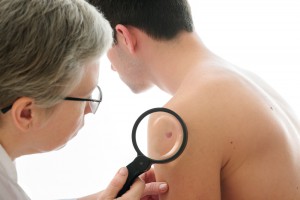
Skin cancers are a common medical problem. They arise in the cells of the skin, which forms the largest organ of the body. Two common forms of skin cancer are squamous and basal cell cancer. Another form is melanoma, which is less common, but is more serious. There are several other types of skin cancer which are rare. The skin is susceptible to sun damage, which can lead to skin cancer. People with fair-colored skin are at increased risk for skin cancer, because they lack the pigments that protect against sun damage. Australia has the highest rate of skin cancer, because Australians are fair-skinned people who get high exposure to the intense tropical sun. Someone with a close relative who had skin cancer is at increased risk. People with numerous moles, called atypical nevi, are also at increased risk for skin cancer.
Skin cancer can be prevented by avoiding sun exposure, particularly in the middle of summer. A history of severe sunburns in childhood is a risk factor for skin cancer. Sunscreen protects against skin cancer by blocking the harmful ultraviolet rays. A suntan can also protect against skin cancer, by protecting against sunburn.
People should check their skin for early signs of skin cancer. Early detection is important, because skin cancer can be cured if found early. Any new lesion and some old lesions should be brought to the attention of your doctor. A raised or fleshy spot, or red or ulcerated lesion could be a squamous or basal cell cancer. Patches of red skin in sun exposed areas could be actinic keratosis, which is a pre-cancerous condition that needs to be monitored by a doctor. Any new or changing mole could be melanoma-type skin cancer. Compared to regular moles, melanoma moles are less symmetric, have irregular borders, are multi-colored, and are larger and deeper. Any mole with these characteristics should be shown to your doctor, even if it is not changing.
Your doctor will decide if you need a skin biopsy. A skin biopsy is when a piece of skin is taken and examined under a microscope.
If the lesion is cancerous, further treatment might be required. Skin cancer is treated with surgery, radiation, or freezing. These treatments usually cure basal and squamous cell cancers. For melanoma, a more extensive skin surgery may be needed, possibly removing some lymph nodes. If the melanoma is thick, ulcerated, or has lymph nodes, it might relapse somewhere else after surgery. It can come back because a few cells might have escaped before the operation. Medicine called immunotherapy may be recommended after surgery, to kill escaped cells and prevent relapse.
If a skin cancer relapses on the skin, it can be cured by more surgery, radiation, or freezing. Melanoma is the one type of skin cancer that often spreads to another part of the body. It often spreads to the liver or lung. Melanoma that has spread can be treated with more surgery, or with medicines called immunotherapy or chemotherapy. Melanoma that has spread is not considered to be curable.
With skin cancer, prevention and early detection offer the best hope. If detected and treated early, most skin cancer will be cured.

